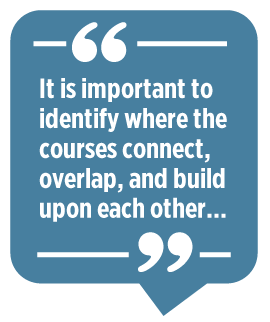|

In the face of a rapidly growing K–12 English language
learner (ELL) population worldwide, many schools and school districts have
struggled to provide training that supports teachers who work with ELL
students. In most cases, they have relied on traditional professional
development (PD) approaches that are convenient and time-efficient, but are
also often episodic, disconnected, short-term, and “nice to know” but not of
immediate application to their classrooms (Teemant, 2014; TESOL International
Association, 2018). In contrast, online licensure and degree programs provide
longer term, more in-depth training, but are often perceived by teachers as
impersonal and distant.
In this
article, we describe how our graduate program at Purdue University has
implemented an online ELL licensure program that has overcome these concerns
about online learning by successfully using teacher cohorts to develop
communities of practice and creating courses that are relevant, accessible, and
engaging for in-service K–12 general education teachers (Morita-Mullaney, Renn,
García, & Wright, 2020). Given the recent and swift migration to online
learning in K–12 and teacher education due to the COVID-19 pandemic, we use our
experience to shed light on how training and preparation for all teachers of
ELLs can persist and be enhanced through an online format.
Components of a Quality
Online Program
Purdue
University’s online ELL licensure program consists of five courses covering
conceptual and applied topics on the language and literacy development of ELLs.
The courses are taught over the course of one calendar year, providing ample
opportunities for reflection as teachers dig more deeply into theoretical and
practical topics related to teaching ELLs. Based on our experience, three key
components make an online program more accessible to K–12 teachers:
- coherent content
- user-friendly
technology
- regular interaction among
students and instructors
Content
Coherence
To attain a
clear, coherent curriculum, it is important to identify where the courses
connect, overlap, and build upon each other to ensure that the courses
reinforce one another, helping teachers to see how the content is connected
across courses. In addition, all class instructors should make sure that
instructional samples are furnished for abstract topics and that concrete
examples are coupled with related scholarship so that teachers are able to make
connections between theory, research, and practice.
 Technology as a
Scaffold and not a Barrier Technology as a
Scaffold and not a Barrier
In-service
teachers are busy and have varying levels of comfort with technology, so it is
important that they can easily find instructions, assignments, and resources
within the online learning management platform. When a course is poorly
designed, students and instructors end up spending a large portion of their
time dealing with technical issues. By working with instructional designers,
programs can create a consistent format across courses and maximize the
accessibility of the content. The online navigation should be clear for users,
allowing technology to serve as a scaffold toward accessing the target content
through the inclusion of supports like videos and interactive presentations and
activities; this can be accomplished with strong planning.
Interaction Is
Key
Finally,
online programs should place a strong emphasis on promoting interaction
throughout all of the courses. Interaction should be frequent, required, and
relevant. It should also be facilitated through both written activities, like
blogs and discussion boards, and oral means, using applications like VoiceThread, a cloud-based
multimedia presentation program where instructors and students can easily
create narrated online presentations. Class members can also post text, audio,
or video comments on any slide to discuss the content. This creates an
engaging, asynchronous conversation that feels more like in-class presentations
and discussions. Using this oral medium allows for a more authentic dialogue,
where teachers can build on each other’s comments and ideas. This supports the
development of a community of practice as teachers connect with their peers as
they reflect on their ELL-focused teaching practices.
Communities of
Practice
Communities
of practice are “groups of people who share a concern or a passion for
something they do and learn how to do it better as they interact regularly”
(Wenger, 2015, p. 1). Communities of practice possess three key elements:
- the domain
- the community
- the practice
Here we describe the three
key elements of communities of practice and explain how they can be
incorporated into programs.
The
Domain
The domain is the shared interest that generates a group
identity. Though teachers may enter the program for a range of reasons, they
all share a commitment to serving their ELL students and an interest in
learning how to do so more effectively. Despite working in different grades and
in a variety of school districts, these shared interests can naturally create
an immediate connection among the program participants. This group identity can
be enhanced by activities, like blogs, where the teachers introduce themselves
and their reasons for joining the program. Encouraging them to then comment on
their peers’ blog posts creates opportunities for finding shared interests and
goals in the process. This allows participants to “get to know” each other,
dispelling the myth that online courses lack connectedness (Kim, Song,
& Coppersmith, 2018). When possible, teachers should be encouraged to
post videos rather than audio or text comments, especially at the beginning of
courses, so that they can actually see each other’s faces. These approaches
help to overcome the “distance” that is often felt in online learning and allow
the group to develop and strengthen a shared identity.
The Community
The community is where members jointly construct understanding
around content of interest with increasing complexity. Because members of the
community learn from one another, it is critical to require frequent, regular
interaction. Major concepts can be introduced through readings, short video
lectures, VoiceThread presentations, and video clips of effective classroom
practices. Discussion boards, blogs, and VoiceThread discussions then provide
opportunities for the teachers to ask questions, make comments, and share
experiences as they make connections between theory, research, and effective
practice for their ELLs. The community can be enhanced through group projects
and field experiences, such as conducting ELL student case-studies in teachers’
own schools and classrooms.

Rather than
establishing the instructor as the sole expert in the class, these projects
enable teachers to collaborate and share across their different school settings
and grade-level classrooms, making the content pertinent to their personal and
professional experiences. One teacher in our ELL program said, “I love our
classroom interactions. At the end of the week I have learned from my
instructor and my fellow students. My classmates often discuss newer topics in ways
that make the content more relatable to me.” When teachers join the program as
a cohort and stay in the same group over the program’s duration, the feeling of
collective belonging deepens over time.
The
Practice
The practice
is where community of practice members codevelop resources and strategies that
inform their shared identities as practitioners. Building understanding and
engagement in an instructional practice entails the sharing of experiences,
stories, tools, and ways of addressing persistent problems (Wenger, 2015). It
takes time to build the necessary trust and understanding required to share a
practice, so it is important that teachers have the time to build those
relationships.
Throughout
the classes, teachers should have regular opportunities to share thoughts,
strategies, and experiences, in order to find overlap with others as well as to
hear different perspectives and new ideas. For some activities, it can be
beneficial to organize participants into small groups based on the grade or the
content area that they teach. This allows students to have more in-depth and
sustained interactions with two to three students, as well as develop a
practice that is specific to their professional context. Throughout the
courses, teachers can be invited to share concerns, successes, failures,
strategies, and instructional approaches, working together to more effectively
teach their ELLs.
Sustaining Communities
of Practice
At the end
of our program, teachers report feeling more knowledgeable and better prepared
to serve their ELLs. A big reason for this is their sustained participation in
a community of practice. Working with other in-service teachers provides them
with a range of views and experiences and a richer, more relevant learning
experience. Program graduates are excited when they recognize each other’s
voices and faces at professional ELL conferences and workshops. They stay in
touch with each other and remain a source of support, continuing to share
knowledge. Furthermore, participants leave the program with increased
confidence and renewed purpose. One graduate, for example, reported seeing
herself as “being more of an advocate for the ELL students in our school and
being more of a teacher-leader” after completing the program. Teachers take on
leadership roles in their schools and districts and become vocal advocates for
their ELLs. Most importantly, they serve as mentors for other colleagues and
build communities of practice within their own schools, districts, and
communities.
References
Kim, S.,
Song, K., & Coppersmith, S. (2018). Creating an interactive virtual
community of linguistically and culturally responsive content teacher-learners
to serve English learners. Contemporary Issues in Technology and
Teacher Education, 18(2), 442–466.
Morita-Mullaney, T., Renn, J.,
Garcia, A., & Wright, W. E. (2020). Preparing K–12 teachers for
effective instruction of English learners: The transformation of a Purdue
University online language teacher education program. In H.S. Kang, D.S. Shin,
& T. Cimasko (Eds.), Online education for teachers of English
as a global language (pp. 19-38). New York: Routledge.
Teemant, A.
(2014). A mixed-methods investigation of instructional coaching for teachers of
diverse learners. Urban Education, 49(5), 574-604.
doi:10.1177/0042085913481362
TESOL
International Association. (2018). The 6 principles for exemplary
teaching of English learners. TESOL Press.
Wenger, E.
(2015). Communities of practice: a brief introduction. Communities of
Practice, 1-8.
Dr. Jennifer
Renn is a researcher in the College of
Education at Purdue University. Prior to joining Purdue, she was an Institution
of Education Sciences postdoctoral fellow at the University of North Carolina
at Chapel Hill’s Frank Porter Graham Child Development Institute and the
director of linguistic and cultural diversity at the Center for Applied
Linguistics. Dr. Renn’s research interests include sociolinguistics, language
assessment, educator training, and language variation and identity.
Dr. Trish
Morita-Mullaney is an assistant professor
at Purdue University. Her research focuses on the intersections between
language learning, gender, and race and how this informs educator identities of
emergent bilinguals. Guided by critical and feminist thought, she examines how
these intersecting identities shape individual and structural policy-making for
emergent bilinguals. She serves as the principal investigator for two Office
for English Language Acquisition grants focused on general education and dual
language teachers throughout Indiana.
Dr. Wayne E.
Wright is associate dean for research,
graduate programs and faculty development, and professor and the Barbara I.
Cook chair of literacy and language in the College of Education at Purdue
University. He is author of Foundations of Teaching English Language
Learners: Research, Theory, Policy, and Practice (3rd ed., 2019),
coauthor of Foundations of Bilingual Education and
Bilingualism (6th ed., 2017), and coeditor of the Handbook
of Bilingual and Multilingual Education (2015). |